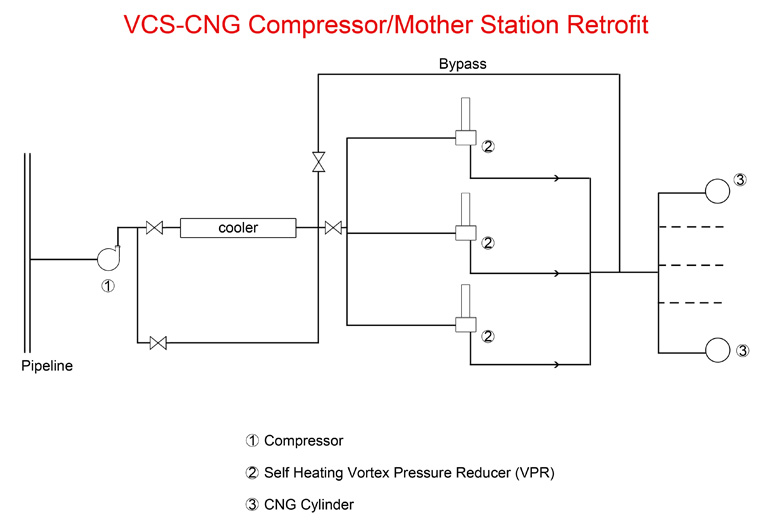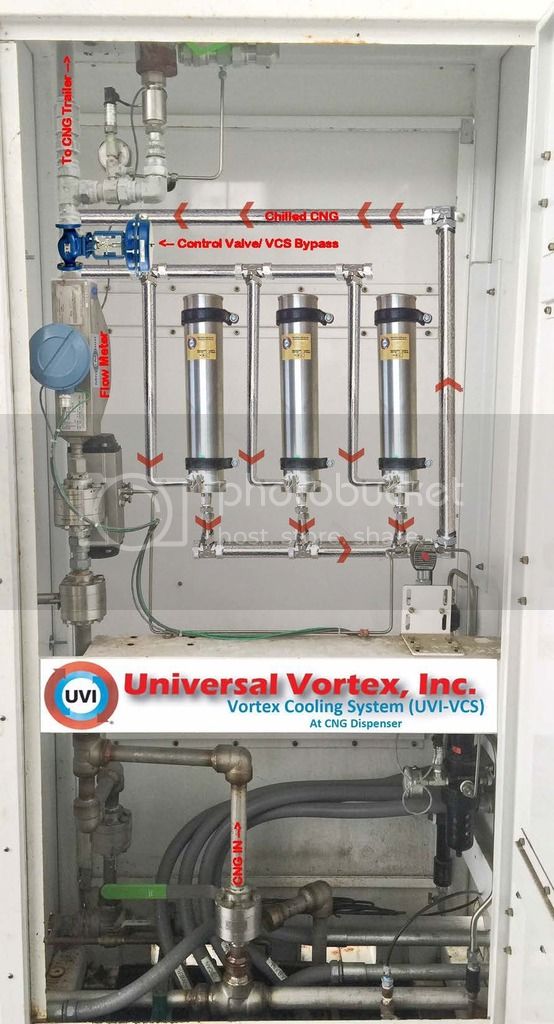VORTEX CNG COOLING SYSTEM (VCS-CNG)
The Vortex CNG Cooling System (VCS-CNG) takes advantage of the low temperatures available at the VPR discharge to chill the compressed gas thereby filling more CNG volume into the CNG tank than a normal (conventional) filling at a CNG station.
Vortex Natural Gas Pre-Cool in CNG Tank Filling Process
Overview
The core of the technology is the proprietary Self-Heating Single Path Vortex Pressure Reducer (VPR) capable of making a non-freeze low temperature gas at the VPR discharge.
The VCS_CNG design takes advantage of the low temperatures available at the VPR unit’s discharge by chilling the compressed gas as it fills the portable CNG tanks.
In the VPR, high pressure gas expands in the unit’s tangential nozzle of a fixed size down to the delivery pressure. While in the VPR cylindrical part, the rotating low-pressure gas undergoes energy division (vortex phenomenon), forming two currents: cold and hot. The currents coexist in the VPR and exit the unit through a single discharge orifice. Prior to exiting the VPR the hottest portion of the hot flow is internally directed to warm up the unit’s inlet nozzle (self-heating provision), thus preventing the inlet depressurized flow freeze up. The vortex cold and the hot flows mixing up at the VPR discharge negate their temperature differences. Therefore, the temperature of the combined flow at the VPR single discharge reflects only Joule Thomson temperature drop in the expanded gas.


Example Configuration
Installed at Filling Dispensers
In the traditional non-VPR scenario, at a CNG station, natural gas at the compressor discharge is directed to fill a portable daughter CNG tank. Once the filling starts and as the gas pressure in the CNG tank increases, the gas temperature increases as well. The warmed, expanding gas creates back-pressure that, eventually, equalizes the maximum filling pressure of CNG tank well before the tank has reached its volumetric capacity.
In the UVI solution, the VCS-CNG design eliminates these negatives and provides for efficient chilling of the content of a CNG tank. In the VCS design, the gas from the compressor discharge is directed to the Self Heating Vortex Pressure Reducer (VPR) that is designed/sized for a total capacity of the compressor at its discharge pressure. The high-pressure gas undergoes non-freeze pressure reduction in the VPR inlet nozzles from the CNG compressor pressure (e.g. 3,700 psi) to the current pressure in CNG tanks; accordingly, the gas temperature drops due to the Joule-Thomson effect in the expanding gas. The chilled gas mixes with the gas presently in the CNG tanks.
The initial deep negative and the following relatively low gas temperatures in the CNG tank provided by the VCS design translate into a stored CNG mass increase as well as in reduction of the CNG tank filling time as compared with the existing filling procedure. Quantitative data is dependent on the material (composite vs. metal) of CNG tank and quality of the CNG supply manifold's insulation at the specified ambient gas temperatures.
The VCS operations will stop and direct compression will resume if the temperature of the accumulated gas in the CNG tank reaches a certain specified “low temperature’’ value. Accordingly, when the tank gas temperature increases, the VPR process will resume.
The table below indicates a range of gas temperatures at the VCS outlet at different tank pressures and various gas temperatures upstream of the VPR (that are the gas temperatures at the compressor discharge).
VPR Outlet Gas Temperature (F)
| CNG Tank Pressure Range (psi) |
VPR Inlet at 60F | VPR inlet at 90F | VPR inlet at 105F |
| 200* -700 | -98 to -46 | -55 to 11 | -33 to 8 |
| 700 - 1,200 | -46 to -9 | -11 to 22 | 8 to 38 |
| 1,200 - 1,700 | -9 to 16 | 22 to 46 | 38 to 61 |
| 1,700 - 2,200 | 16 to 33 | 46 to 62 | 61 to 70 |
| 2,200 - 2,700 | 33 to 46 | 62 to 75 | 77 to 90 |
*residual pressure
At lower ambient temperatures the gas temperature at the VPR discharge will decline proportionally. At filling station with the VCS retrofit the existing chiller (if any) can be turned off at moderate and low ambient temperatures (e.g. most of the time) thus saving the operational cost.
The VPR operations will stop and direct compression will resume when temperature of the accumulated gas in CNG tanks reaches a certain specified “low” temperature. Accordingly, when the tanked gas temperature increases, the process will again turn to VPR.
At a tank pressure above 2,700 psi, the ratio of VPR inlet and outlet pressures (the unit driving force) become too small to generate enough heating duty to efficiently warm up the unit’s inlet nozzle. Therefore, the gas at the compressor’s discharge bypasses the VPR and goes directly to the CNG tank.

